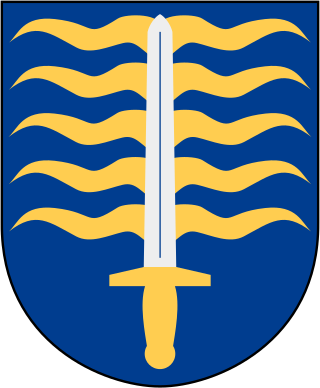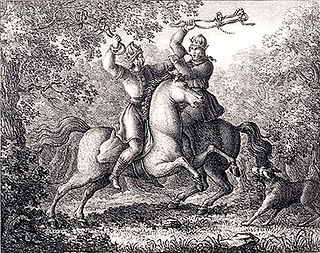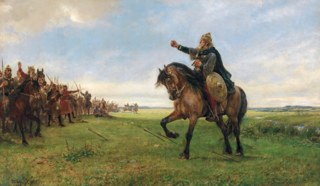
Tyrfing, also rendered as Tirfing or Tyrving, was a magic sword in Norse mythology, which features in the Tyrfing Cycle, which includes a poem from the Poetic Edda called Hervararkviða, and the Hervarar saga. The name is also used in the saga to denote the Goths.
Halfdan the Old was an ancient, legendary king from whom descended many of the most notable lineages of legend. A second Halfdan the Old is the purported great-grandfather of Ragnvald Eysteinsson.
Various gods and men appear as sons of Odin in Old Norse and Old English texts.

Harald Wartooth or Harold Hiltertooth was a semi-legendary king of Denmark who is mentioned in several traditional sources. He is held to have (indirectly) succeeded his father as king of Zealand and to have expanded his realm. According to different sources, he may have ruled over Jutland, part of Sweden and the historical northern German province of Wendland. He is said to have been finally defeated and killed at the legendary Battle of Bråvalla.
Randvér or Randver was a legendary Danish king. In Nordic legends, according to Sögubrot and the Lay of Hyndla, he was the son of Ráðbarðr the king of Garðaríki and Auðr the Deep-Minded, the daughter of the Danish-Swedish ruler Ivar Vidfamne. In these two sources, Auðr had Randver's brother, Harald Wartooth, in a previous marriage.

Alaric and Eric, according to legend, were two kings of Sweden.
The Scyldings or Skjǫldungs, both meaning "descendants of Scyld/Skjǫldr", were, according to legends, a clan or dynasty of Danish kings, that in its time conquered and ruled Denmark and Sweden together with part of England, Ireland and North Germany. The name is explained in many texts, such as Friedrich Christoph Dahlmann's 'Research on the Field of History', by the descent of this family from an eponymous king Scyld, but the title is sometimes applied to rulers who purportedly reigned before him, and the supposed king may be an invention to explain the name. There was once a Norse saga on the dynasty, the Skjöldunga saga, but it survives only in a Latin summary by Arngrímur Jónsson.

Hervarar saga ok Heiðreks is a legendary saga from the 13th century combining matter from several older sagas in Germanic heroic legend. It tells of wars between the Goths and the Huns during the 4th century. The final part of the saga, which was likely composed separately from and later than the rest, is a source for Swedish medieval history.

Hjalmar and Ingeborg were a legendary Swedish duo. The male protagonist Hjalmar and his duel for Ingeborg figures in the Hervarar saga and in Orvar-Odd's saga, as well as in Gesta Danorum, Lay of Hyndla and a number of Faroese ballads. Hjalmar never lost a battle until meeting a berserker wielding the cursed sword Tyrfing.
Gestumblindi is a personal name appearing in two medieval Scandinavian legendary texts: Hervarar saga ok Heiðreks and in Saxo Grammaticus' Gesta Danorum. A figure of this name also appears in several later Scandinavian folk tales as Gest Blinde.

Hervör is the name shared by two female characters in the Tyrfing Cycle, presented in The Saga of Hervör and Heidrek with parts found in the Poetic Edda. The first, the Viking Hervör, challenged her father Angantýr's ghost in his gravemound for his cursed sword Tyrfing. She had a son, Heidrek, father of the other Hervör. The second Hervör was a commander killed in battle with her brother.

Svafrlami was in the H and U version of the Hervarar saga the son of Sigrlami, who was the son of Odin. In the R version, Svafrlami is called Sigrlami and his parentage is not given. Svafrlami was the king of Gardariki and the first owner of the magic sword Tyrfing.
Angantyr was the name of three male characters from the same line in Norse mythology, and who appear in Hervarar saga, Gesta Danorum, and Faroese ballads.
Árheimar was a capital of the Goths, according to the Hervarar saga. The saga states that it was located at Danparstaðir, which is identified with the ruins of Kamjans'ke Horodyšče, near Kamianka-Dniprovska in southern Ukraine.

Bolmsö is an island located in lake Bolmen near Växjö in Småland. It had 382 inhabitants in 1998.
Eyfura was a princess in Norse mythology, who married Arngrim and had twelve sons. In all accounts, her twelve sons would be slain by the Swedish champion Hjalmar and his friend Orvar-Odd.
Ásmundar saga kappabana is the saga of Asmund the Champion-Killer, a legendary saga from Iceland, first attested in the manuscript Stockholm, Royal Library, Holm. 7, 4to, from the first half of the fourteenth century. It is essentially an adaptation of the German Hildebrandslied, but it has assimilated matter from the Tyrfing Cycle.
Munarvágr was a location on the southern shore of Samsø, which is mentioned in the legendary sagas Hervarar saga and Ragnar Lodbrok's saga.
The Dagling or Dögling dynasty was a legendary clan of the petty kingdom Ringerike in what today is Norway. It was descended from a Dag the Great.

The Haddingjar refers on the one hand to Germanic heroic legends about two brothers by this name, and on the other hand to possibly related legends based on the Hasdingi, the royal dynasty of the Vandals. The accounts vary greatly.









